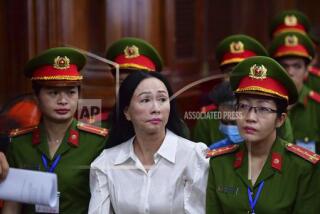Van Tien Dung, 84; Led N. Vietnam in Capturing Saigon
- Share via
Gen. Van Tien Dung, who commanded the North Vietnamese forces that captured Saigon in the final act of the Vietnam War, has died, Vietnam’s Foreign Ministry announced Tuesday.
Dung, 84, died Sunday at Hanoi’s Central Military Hospital, said ministry spokeswoman Phan Thuy Thanh. The cause of death was not disclosed.
After a formal state funeral Thursday, Dung will be buried at the Mai Dich Cemetery on the outskirts of Hanoi, reserved for the highest-ranking Communist Party and government officials, Vietnam Television announced.
Born in Hanoi and a member of the Communist Party by the time he was 20, Dung rose from peasant stock to become part of an elite handful of revolutionaries who masterminded Vietnam’s war of independence against France.
He was named Hanoi’s military chief of staff in 1953 and went on to fight against American forces during the Vietnam War.
Dung headed the final Communist offensive against U.S.-backed South Vietnam in the spring of 1975. The war came to an end on April 30 of that year as North Vietnamese tanks rolled through the gates of the Presidential Palace in Saigon, South Vietnam’s capital.
Dung’s military reputation in Vietnam stands second only to battlefield legend Gen. Vo Nguyen Giap, who along with Ho Chi Minh and Pham Van Dong were considered the architects of the nation’s communist revolution.
He wrote a surprisingly detailed and candid account of the offensive leading to Saigon’s collapse that was serialized in Hanoi’s leading newspapers in 1976.
Experts found the memoir, called “The Great Spring Victory,” straightforward and reasonably accurate.
Although Dung’s chronicle broke no news, it was valuable because it confirmed the U.S. government’s theories about North Vietnamese strategy during the final phase of the war.
He revealed that North Vietnam’s leaders did not expect the final offensive to succeed as quickly as it did. He said he was incredulous when hundreds of thousands of South Vietnamese troops and civilians fled from Pleiku in the Central Highlands--the beginning of the conquest of the South.
“Why such a retreat? And who had given the order for it?” he asked, recording his thoughts at the time.
Dung’s memoir also read as lively military history because of Dung’s personal notes and descriptions of cloak-and-dagger maneuvers.
When the wary general departed for South Vietnam in 1975, for example, he took pains to keep intelligence agents from noticing his absence. Before leaving Hanoi, he arranged for a double to ride in his Soviet Volga sedan for his regular twice-daily trips between his house and military headquarters. He also arranged for an army volleyball team to come to his house every afternoon “because I have the habit of playing volleyball after the afternoon working hours with them.” The activities were reported in the Hanoi press as if he were still there.
The prominent play given to his memoirs made Dung a national hero and signaled to analysts that the down-to-earth general was to be elevated to the heroic stature of his mentor, Giap.
In 1973, Giap was diagnosed with Hodgkin’s disease and by 1975 his role had become largely ceremonial. Dung, the only other four-star general in the North Vietnamese army, was credited by Western military experts with overhauling and reorganizing North Vietnam’s army into a modern military force. In 1980, the year after Vietnam toppled the government of neighboring Cambodia, he replaced Giap as defense minister.
In later years Dung was dogged by criticism from within the army for his autocratic style and rumors of family corruption. He was replaced in 1986 during a Cabinet shuffle.
He is survived by his two sons and three daughters.
More to Read
Sign up for Essential California
The most important California stories and recommendations in your inbox every morning.
You may occasionally receive promotional content from the Los Angeles Times.













